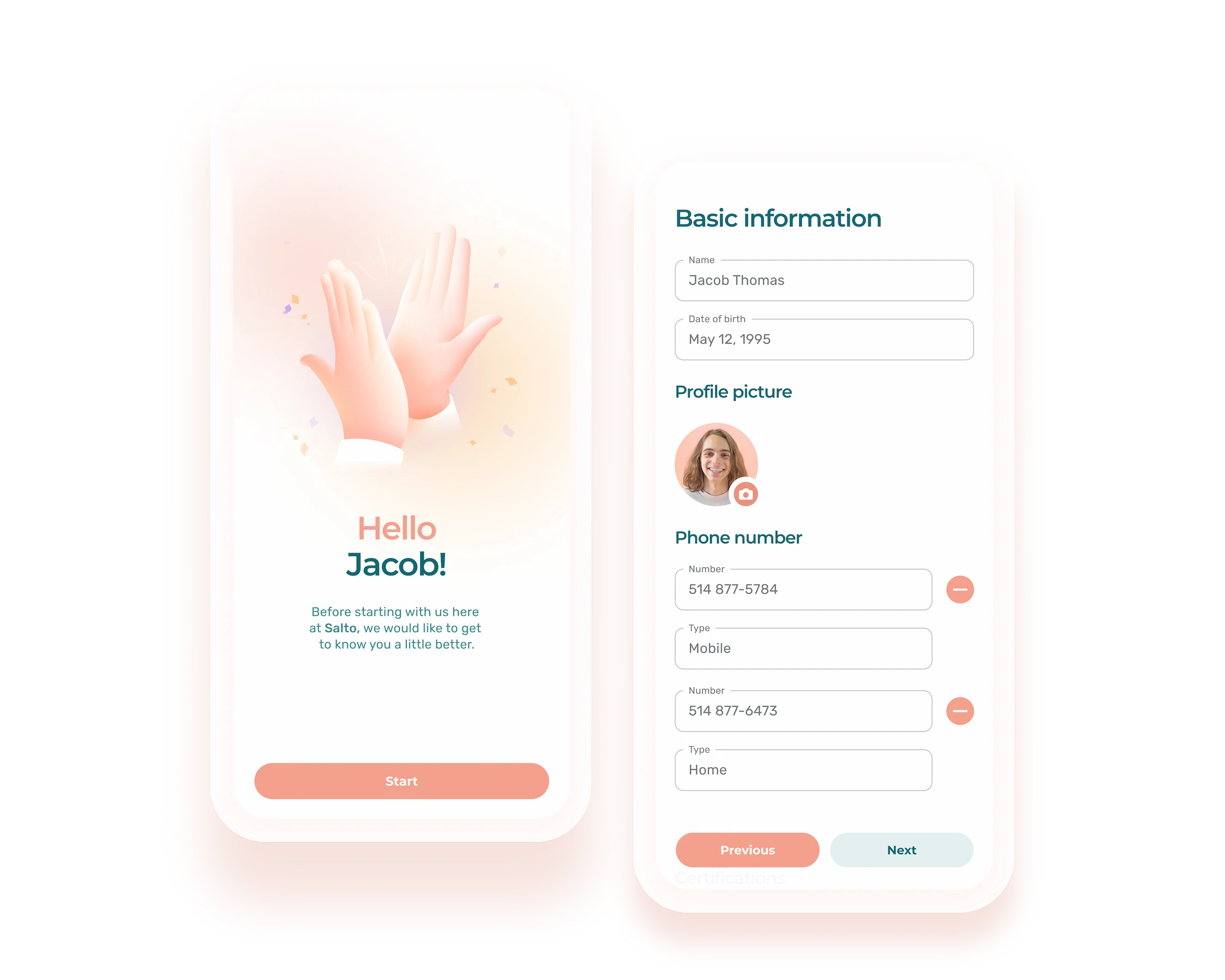Onboarding retail employees successfully has become increasingly difficult in the last couple of years. Having an efficient employee onboarding process improves employee retention.
It also ensures customers continue to enjoy efficient and consistent service at all times. Follow these 8 simple steps to improve your retail employee onboarding.
Benefits of a Successful Retail Onboarding Process
Knowing how to effectively onboard retail employees is one of the keys to success in the retail industry. Engaging hourly workers from their very first day and setting them up for success will lower your employee churn rate and maintain the high level of customer service your retail business strives for.
Creating a successful onboarding process will support the growth of your retail store in a number of ways.
Benefits of a Successful Onboarding Process:
Reduces Employee Churn
Half of all hourly workers leave their jobs within three months. Those who go through a well-structured onboarding program are 69% more likely to remain at the company for up to three years. See our 8 tips to boost your employee retention.
Slashes Recruiting, Hiring and Training Costs
Employee turnover costs retailers billions of dollars in recruiting, hiring and training costs each year. Studies show that the cost to replace an entry-level employee can be as high as 50% of their annual salary.
Improves Employee Productivity and Performance
High churn rates among retail staff is also costly in terms of performance. Roughly 230 million days of lost productivity is associated with retail employee churn.
Protects the Business From Lost Profitability
Constantly having to onboard new hires monopolizes valuable time that other employees could be devoting to improving the customer experience, and therefore, sales.
Boosts Team Morale
Having a high employee turnover rate can destroy staff morale and cause employee departures to snowball. This can jeopardize a company’s ability to maintain even a basic level of customer service.
Improves Customer Service and Customer Satisfaction
Having an effective onboarding process can drastically improve company profitability and customer satisfaction scores.
Ensures a Consistent Shopping Experience and Customer Loyalty
Studies show 90% of consumers base their decision of whether or not to do business with a company on customer service.
Phases of the Retail Onboarding Process
There are four main stages of the retail onboarding process:
- Preboarding: Collecting the employee’s personal information, preparing the necessary HR paperwork, and providing the employee with any information or resources needed for the first day at work.
- First day: Introducing the employee to their new workplace, role, work tools, teammates, and supervisors.
- First week: Setting initial performance objectives for the employee and providing the necessary training to do the job.
- First month: Closely monitoring and supporting the new employee to ensure a successful integration and that performance expectations are being met.
8 Steps to Retail Onboarding Process
Below is a handy checklist of the key steps in onboarding retail workers. These steps should be included in any retail onboarding program. This process is equally important for seasonal retail workers.
Before the First Day (Preboarding)
Step 1: Gather Basic Information
- Prepare paperwork
- Send welcome message to the new employee
- Add the new employee to company email lists
- Schedule a welcome meeting
- Assign a mentor to the new employee
- Notify the relevant department
- Provide the new employee the employee handbook with all the relevant information, such as dress code
Step 2: Define Role and Set Tasks
- Clearly define the new employee’s role, along with a list of tasks to be performed
See how Agendrix software can improve all aspects of employee management, including employee onboarding.
First Day
Step 3: Orientation and In-Person Welcoming
- Plan an introductory session to welcome new employees
- Read through employee handbook together
- Tour the retail store or work areas
- Pair the new employee with an experienced staff member, buddy or mentor
- Describe the company’s vision, mission and values
- Plan a welcome lunch with the team
Step 4: Introduction to Training
- Introduce the employee to work tools and systems, such as the computer and telephone systems
- Provide the relevant training content so that the employee can start mastering the use of these systems
First Week
Step 5: Goal Setting
- Set initial goals for new employees for their first few weeks or months
- Discuss these goals with the employee, along with relevant information on the level of effort required to reach these goals
- Provide the new employee resource people to turn to for help or advice in reaching these goals
Step 6: Continued Training
- Continue to provide new retail workers ongoing training as they develop a better understanding of their role
First Month
Step 7: Regular Check-Ins
- Regularly check in with new frontline workers to ensure they have the necessary resources and training to perform their duties
Step 8: Assess Performance and Get Feedback
- Schedule a performance review meeting to assess the performance of new frontline employees
- Collect feedback from new employees about your hiring process and onboarding programs
- Keep the lines of communication open by inviting your retail workforce to share feedback on their employee experience and job satisfaction
Best Practices for Retail Employee Onboarding
Ensuring adequate staffing is a chronic problem in the retail industry. A poor onboarding process can quickly turn off new hires, putting employee retention at higher risk.
The following best practices for effective onboarding in retail will improve the employee experience right from day one.
1. Make Preboarding a Delight
One of the biggest mistakes retail businesses make is underestimating the importance of the preboarding stage for employee retention. Most candidates are beaming with enthusiasm during the interview stage. But in retail, where open positions are available at every turn, interest in a new job can fade quickly.
The preboarding stage is crucial to keeping this spark alive:
- Send new hires a personalized welcome message, inviting them to reach out if they have any questions
- Ask new hires to complete their employee profile
- Offer new staff access to information about their future team
- Provide new hires short and engaging preboarding videos or reading materials to start aligning them with the company’s mission, vision, and values
- Have new hires complete all administrative paperwork
- Provide new staff the employee handbook
- Share information about pay, time off requests, holidays, benefits, etc.
- Detail the new hire’s first day schedule to get them excited and help them prepare for the big day. Here are more retail scheduling best practices
All of the above will help new retail store staff feel like they are part of the team even before their official first day on the job. It will reinforce the feeling that they’ve made the right choice, and make them less likely to entertain any other job offers that might come in.
2. Communicate the Company Culture Early On
All companies have their own way of doing things-how information is communicated, how decisions are made, and how staff treat one another.
Communicating the company culture early and often will let employees know what attitudes and behavior are encouraged versus those that could lead to problems or even disciplinary action.
3. Make Their First Day Memorable
Chances are the employee is doing everything they can to make a good first impression. As the employer, you should, too.
- Show them around: give your new hire a tour of their new workspace and work tools.
- Make introductions: introduce your new hire to their co-workers and the team. Give them multiple opportunities to get to know everyone so that they can feel part of the team.
- Set up their workspace: make sure new employees have everything they need to get started and be productive right off the bat.
- Give them something to do: start small, but give new employees an opportunity to demonstrate their value right from day one.
- Create a sense of community: invite new staff to the company’s social media and networking groups, and be sure to invite them to any upcoming team gatherings.
- Take them to lunch: this is a great way to show a new hire that they are valued. Everyone loves a free meal, plus it gives you a chance to chat outside the workplace and get to know them. Let them know ahead of time so that they don’t have to worry about where or what they’ll be eating for lunch on their first day.
4. Keep Their Schedule Tightly Structured
Nothing is more demoralizing in retail roles than being thrown into the deep end and left to one’s own devices. It’s sure to lead to a poor onboarding experience and poor employee retention.
- Keep new employees on a structured schedule until they are comfortable in their role.
- If new hires are supposed to shadow someone, make sure the person they are paired with understands the importance of shadowing. They should make an effort to put the new hire at ease and be willing and able to clearly explain certain processes or tasks.
- When delegating tasks to new hires, make sure they are closely supervised or have someone they can consult at all times.
- Avoid letting new hires hang around until you feel they know enough to get down to work. All good retail employees want to contribute something of value–even young and inexperienced workers.
5. Set Expectations Early and Often
All employees need to know what is expected of them in their job. Otherwise, it can lead to poor employee performance and frustration.
- Set expectations in line with the employee’s experience and job and communicate them clearly.
- Adjust expectations with new hires as they become more competent in their role, and discuss them with the employee.
- Continue to add reasonable challenges to keep employees motivated and engaged.
6. Don’t Expect New Hires to Hit the Ground Running
Every new job comes with its own learning process. Even seasoned industry pros need time to learn the ropes.
- Make sure all employees go through the full onboarding process. It shows fairness, a respect for processes, and a commitment to excellence.
- Resist the temptation to cut corners on their onboarding and training in an attempt to meet quotes or customer demands. Doing so will only lead to frustration and most likely, high employee churn.
7. Allow New Hires to Give Their Own Feedback
All retail businesses employees–including seasonal workers–need regular feedback from superiors. Getting feedback from retail workers is just as important for business success.
- Use this feedback to identify areas for improving your hiring process, onboarding programs, and employee experience.
Onboarding Employees Software for Retail
Agendrix employee onboarding software provides companies and HR departments a great tool to properly welcome, learn about, and guide new hires. It centralizes key information about your employees, putting an end to lengthy paperwork.
No paper forms minimizes the risk of oversights and errors. Instead, you get an incredibly easy-to-use tool to achieve an efficient and personalized onboarding process.
- Manage employee onboarding as well as scheduling (including training shifts, for example), time sheets, time off requests, etc.
- Benefit from flexible and affordable monthly plans that adjust to your business needs.
- Get full user training and ongoing support-for and by humans.
What Are the 5 C’s of Onboarding?
The 5 C’s of employee onboarding are:
- Compliance: ensuring the onboarding program complies with legal rules and obligations
- Clarification: ensuring new employees have a clear idea of their roles and performance expectations
- Confidence: ensuring new hires feel they are capable of handling their new jobs
- Connection: ensuring new hires feel that they made the right decision in accepting the job
- Culture: ensuring new hires understand the company’s mission, vision and values
Businesses that focus on the 5 “C’s” report more successful onboarding and business outcomes than those that do not.
How Do I Improve the Retail Onboarding Process?
A good onboarding process for retail employees is one that follows a clear and structured process. It should be continuously improved over time. A good first step is to find the best employee onboarding software for your retail business. It will allow you to simplify your onboarding process and adhere to the 5 C’s of employee onboarding.
What Is a Typical Onboarding Process?
The typical onboarding process in retail includes 4 stages:
- Preboarding: Preparing new hires prior to their first day on the job and may involve providing resources such as your employee handbook or a name tag.
- First day: Providing new employees with in-person orientation and introductions to co-workers, supervisors, as well as workplace and work tools.
- First week: Providing training and setting goals. Retail scheduling software can help you better manage employee schedules.
- First month: Regularly checking in with new employees and providing feedback on their performance. Inviting employees to share their feedback as well. Providing additional training.
While hourly employees generally take about three-and-a-half weeks to onboard fully, most retail managers and supervisors say that it generally takes a new hire about three months to become fully functional in their role.
What Industries Need an Employee Onboarding Program?
Virtually all businesses that hire and train new workers can benefit from creating an onboarding program.
- Retail stores
- Pharmacies
- Retirement homes
- Construction firms
- Restaurants & bars
- Hotels & hospitality
- Events & recreation
- Seasonal & tourism
- Cleaning services
- Catering
- Healthcare
- Offices & call centers
- Home care
- Security services
- Cities & municipalities
Creating an effective employee onboarding program is an ongoing process that should be improved over time.










